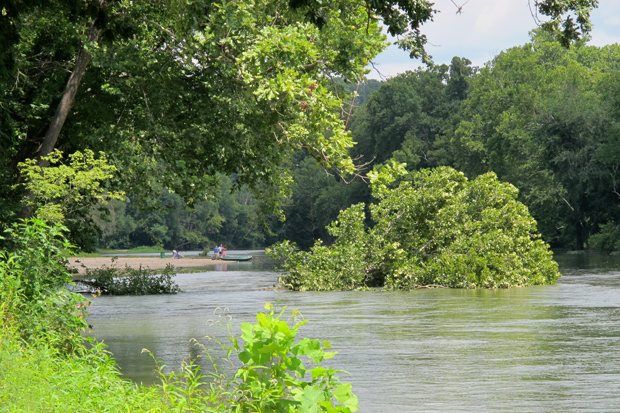
A group of Tulsa bartenders prepare for a day on the Illinois River at Diamondhead Resort near Tahlequah, Okla.
Logan Layden / StateImpact Oklahoma


A group of Tulsa bartenders prepare for a day on the Illinois River at Diamondhead Resort near Tahlequah, Okla.
Logan Layden / StateImpact Oklahoma

Logan Layden / StateImpact Oklahoma
A group of Tulsa bartenders prepare for a day on the Illinois River at Diamondhead Resort near Tahlequah, Okla.
This is part one of StateImpact Oklahoma’s four-part series on the history of Oklahoma’s scenic rivers and the environmental threats they face.
Even though it’s a Monday morning, rowdy Tulsans pile into a bus at Diamondhead Resort and rumble toward the nearest access point into the Illinois River.
“If you have a good group of people and enough alcohol you can make anything fun,” one floater tells StateImpact.
They head off to enjoy a booze-soaked afternoon on the water, oblivious to the decades of effort it took to keep this water clear and the river flowing.
The six eastern Oklahoma waterways classified as scenic rivers are each examples of the pristine beauty of that part of the state. They’re also tourist magnets.
Ed Fite has been the executive director of the Oklahoma Scenic Rivers Commission for the last 32 years. The agency was created in the late 1970s to oversee the Illinois and Upper Mountain Fork rivers, Lee, Little Lee, Barren Fork and Flint creeks.

Logan Layden / StateImpact Oklahoma
Oklahoma Scenic Rivers Commission Executive Director Ed Fite next to a mountain of life vests at the War Eagle Resort near Tahlequah, Okla.
“It hasn’t been a very easy row to plow,” Fite says. “At some of these planning meetings back in the ’70s, there would be, for instance, a rancher from over on Barren Fork Creek, called out one of the federal employees who was here doing a study, and threatened his life. There have been local residents that have pitted themselves against each other.”
The creation of the commission was the culmination of a fight that has its origins in the Wild and Scenic Rivers Act passed by Congress in 1968. Jeff Briley with the Oklahoma History Center says the late ’60s and early ’70s were an important time in the development of environmental regulations.
The national spotlight began to shine on the condition of many of the country’s river systems with the 1968 bill, but it had little effect in Oklahoma. None of the state’s rivers were on the list. But something happened in Ohio the following year:
“And then in 1969 the Cuyahoga River caught fire, literally caught on fire from pollution,” Briley says. “Here we had so damaged the environment that the river caught fire, truly a nightmare scenario. People were so shocked by that.”
Then, even in Oklahoma, the public’s attention turned to the environment, pollution, and protecting rivers. Some legislators wanted rivers in the Illinois watershed to be included in the federal government’s new system, which would mean the use of eminent domain to seize land and water rights.
But former State Rep. James Townsend’s attention had already been on rivers for years, and he had an Oklahoma solution. Ed Fite calls him the godfather of the state’s Scenic River Act.

Logan Layden / StateImpact Oklahoma
Former State Representative James Townsend, who wrote Oklahoma's Scenic Rivers Act.
“As a boy, the rivers and streams were my playgrounds,” Townsend says. “A lake is just a lake, but I want to tell you, a river or a creek has its own personality. And you get acquainted with it and you love it.”
In 1970, finally feeling he had enough support in the legislature, Townsend delivered a stirring speech just before the vote. No tape exists, but Townsend, now 86, summons his old oratory to recite the final lines once again:
“Oklahoma’s future is bright only so long as our air is fresh and our water is clean. Oklahomans wake up. The slimy shadows of pollution is approaching and threatening our environment. It must be attacked. It must be stopped. Environment first, industry second, Oklahoma always!”
The bill passed, but it took seven more years for the law to get teeth — until the creation of the scenic rivers commission after another push for federal intervention.

Logan Layden / StateImpact Oklahoma
The Illinois River flows around a recently fallen tree near one of the waterway's public access points.
Fite says by the late ’60s the unique beauty of these rivers in particular was under pressure from tourists, dams, and the growth of industry and population in northeast Oklahoma and northwest Arkansas.
“We had a lot of trash that was being left by people floating rivers and accessing the river, and there wasn’t a management strategy in place, and so that trash never got picked up and it just accumulated,” the river commission’s Ed Fite says. “The second thing is the city of Tulsa had a prospective dam on the books where they wanted to dam up the Illinois River around the Houston Bluff area to be a water supply for the city of Tulsa.”
The Scenic Rivers Act prevents Tulsa from turning part of the watershed into a lake without legislative approval, and there’s no indication the city will ever seek it. But many of the same problems that plagued these rivers 40 years ago remain the biggest threats to them today.